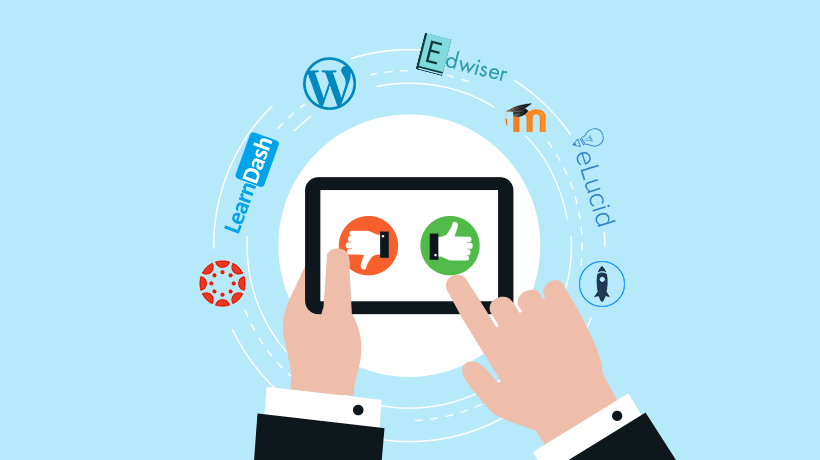Power Up Your LMS By Integrating It With WordPress
As a top eLearning pro or course creator, you need the best tools to deliver your content and manage your courses. A Learning Management System (LMS) provides features like course management, student tracking, and collaboration tools, but why stop there? Unleash the full potential of your eLearning experience with the integration of WordPress.
WordPress is the world's most popular content management system (CMS), powering millions of websites around the globe. By integrating WordPress with your LMS, you can create a central hub for all of your online learning activities, allowing students to access course content, track their progress, and interact with other learners and instructors from within your WordPress website.
In this article, we'll explore the benefits of integrating WordPress with your LMS, and provide step-by-step instructions for setting up and managing the integration. We'll also cover tips and best practices for designing and organizing course content within WordPress, integrating third-party tools and services, and maintaining and updating the integration over time.
What Is A Learning Management System?
A Learning Management System is the backbone of online courses. With features like course management, student progress tracking, assessments and grading, and collaboration tools, it's a total solution for delivering online education. Also, many LMSs have integrations with other tools and services like payment processors, content libraries, and email analytics.
Enter WordPress, the most widely-used content management system that has always been a flexible and customizable option for eLearning professionals. In recent times, WordPress has only got better, and now integrates flawlessly with LMSs. Today, there are a wide variety of WordPress plug-ins and themes that make it easy to integrate WordPress with your LMS and create a seamless and integrated learning experience for students. It’s not difficult to turn your WordPress site into a professional-looking online course platform with the integrations we’ll show you.
Why Would You Want To Integrate WordPress With An LMS?
There are several benefits to integrating WordPress with an LMS, including:
- Seamless User Experience
Integrating your LMS with WordPress means you've got one central hub for all your online learning activities, letting students easily access course content, track their progress, and connect with other students and instructors all from within your WordPress site. No more jumping from one system to another to get their work done! - Centralized course management
Integrating your LMS with WordPress makes managing and organizing your online courses a breeze. Utilize WordPress to create custom pages and post types for displaying course content, and take advantage of plug-ins and themes to make your course pages look amazing. - Enhanced functionality and customization
By using WordPress as the front-end interface for your LMS, you unlock the full potential of WordPress plug-ins and themes, adding interactive quizzes, multimedia content, social networking tools, and more to your eLearning platform. - Improved performance and scalability
Integrating your LMS with WordPress helps ensure your eLearning platform runs smoothly, even with a high volume of traffic and data. WordPress is a powerful and efficient CMS. You will be able to handle large volumes of content, even if you are scaling through Artificial Intelligence (AI) video generators for your course content.
Step-By-Step Instructions To Integrate WordPress With Your LMS
We have broken down the process into five main steps to make the integration as seamless as possible. These steps are a great way for anyone to gain the know-how to complete this integration, even without prior knowledge. The five main steps are:
- Choose an integration approach
- Install and configure the necessary WordPress plug-ins or themes
- Import and organize course content
- Set up user accounts and permissions
- Customize and test the integration
1. Choose An Integration Approach
Before you start the process of integrating your LMS with your WordPress website, it's important to choose an integration approach that meets your needs and fits your budget. There are several different approaches to integrating an LMS with WordPress, each with its own set of benefits and considerations:
- Using WordPress plug-ins
One option is to use a WordPress plug-in to embed LMS content in your WordPress website. There are a number of LMS plug-ins available that allow you to do this, such as the WP Courseware plug-in or the LearnDash plug-in. This approach can be relatively easy to set up, and it allows you to use WordPress as the front-end interface for your LMS. However, it may not offer as much customization or control as some of the other approaches. - Embedding LMS content in WordPress
Another option is to use the LMS's embedding or frame tools to display LMS content directly on your WordPress website. This can be a good option if you want to keep your LMS and WordPress websites separate, but still provide a seamless User Experience. However, this approach may not allow you to customize the appearance of the LMS content within WordPress, and it may require more manual effort to keep the content up to date. - Using WordPress as a front-end interface
A third option is to use WordPress as the front-end interface for your LMS and use WordPress plug-ins or APIs to access and display LMS data and functionality. This approach can offer a high degree of customization and control, but it may require more advanced technical skills and resources to set up and maintain.
2. Install And Configure The Necessary WordPress Plugins Or Themes
Get ready to integrate your LMS and WordPress website with ease! Depending on your approach, you may need to install some plug-ins or themes to get the integration going. If you're using a plug-in to embed LMS content on your WordPress site, make sure you've got that installed and activated. And if you're using WordPress as the face of your LMS, you'll probably need to install some plug-ins or themes that link to your LMS's API or data.
Make sure to read the instructions carefully, and follow the developer's advice for installation and configuration. If you're not sure, reach out to your web host or tech support for help. After you've got everything installed, it's time to set it up to work with your LMS. This might include entering API keys or other credentials, or picking the options for how the integration should work. Finally, test it all out to make sure it's working like a charm!
3. Import And Organize Course Content
Now that your LMS and WordPress websites are all set up, it's time to get your course content organized in WordPress. You'll want to import it from the LMS and put it in the right place. Depending on how you want to set it up, you might need to use the LMS's import tools, or maybe you can use WordPress plug-ins or APIs to transfer everything over.
It's crucial that you take your time and get your course content organized just right in WordPress. You want your students to easily understand and navigate through everything. Think about creating a structure with top-level pages for the main sections or modules, and then use child pages or posts for the individual lessons or topics. And don't forget about WordPress's built-in tags and categories, to help organize it all.
If you've got a ton of content, custom post types could be your new best friend. They let you create custom content types with their own fields, templates, and even taxonomies. It's perfect for organizing and displaying more complex or structured content like quizzes, assignments, or multimedia resources.
4. Set Up User Accounts And Permissions
Alright, now that you've got all your course content organized in WordPress, it's time to get your user accounts and permissions set up. You want to make sure everyone has just the right amount of access, whether they're instructors or students. In WordPress, you've got built-in user roles and capabilities to keep things organized. Give instructors the power to create and manage courses and assignments, and keep students restricted to only the course content and activities. And if you want to get even more specific, you can use the built-in user groups and permissions to control access to specific pages, posts, or custom post types.
Don't forget about the LMS side of things! You'll want to set up user accounts and permissions there too. Keep everything consistent with the roles and groups you've set up in WordPress, and give instructors the ability to create and manage courses, while limiting students to only the course content and activities. It's super important to get this right! You want your students to have the access they need to succeed, but you also want to keep your course content secure and protected. So take your time and plan it out carefully.
5. Customize And Test The Integration
Let's get started on customizing and testing your LMS and WordPress website integration. You've done the hard work of setting up the website and importing all your course content, now it's time to make sure everything is seamless and functioning properly. To give your WordPress website the professional look that other online course platforms have, you can experiment with different themes, or even create custom templates using page builders for a more interactive experience. Don't be afraid to add some personality to it! And if you want to level up, try out some plug-ins, like quizzes, assignments, or discussion forums. These little extras can make a huge difference.
Now, the real test is to enroll in a course and give it a spin. Check everything from accessing course content, to submitting assignments and participating in discussions. And remember, different user roles and groups have different needs and permissions, so test the integration from their perspectives too! It's crucial to ensure that everyone has what they need to succeed.
Additional Useful Skills To Make Your Integration Seamless
As integrating WordPress with an LMS often involves large amounts of data with user accounts and course content, one useful skill to have is a knowledge of SQL, which is a programming language for managing datasets and is used in WordPress’ database system. SQL can be a useful skill to have when integrating an LMS with a WordPress website, as it allows you to more easily manipulate and manage data between the two systems. SQL is a programming language specifically designed for managing and querying databases, and it is widely used in web development and data management.
For example, if you are using WordPress plug-ins or APIs to transfer data between the LMS and WordPress, you may need to write SQL queries to retrieve and update data in the LMS's database. You may also need to use SQL to create or modify tables and fields in the database, or to import or export data from the LMS. Knowing SQL can also be helpful if you need to troubleshoot issues with the integration, as you can use SQL to inspect and debug the data being transferred between the LMS and WordPress. There are several ways to quickly learn SQL. You can look for SQL courses online for a quick solution to get you up to speed. LinkedIn Learning is an excellent platform with affordable prices and comprehensive offerings for this application.
Wrapping Up And Conclusion
In conclusion, integrating an LMS with a WordPress website can be a powerful way to create a seamless and engaging learning experience for students. By following the five-step process outlined in this article, you can set up and configure your LMS and WordPress website, import and organize your course content, set up user accounts and permissions, and customize and test the integration to ensure that everything is working as expected. Along the way, to make your integration process easier, learning SQL can be a useful skill as it allows you to more easily manipulate and manage data between the two systems. By following these steps and using the right tools and resources, you can create a powerful and effective learning platform that meets the needs of your students and your organization.









